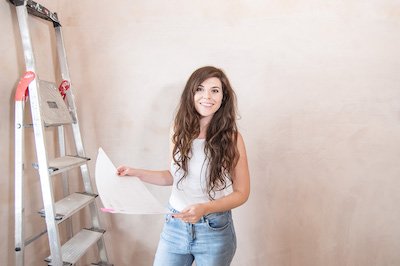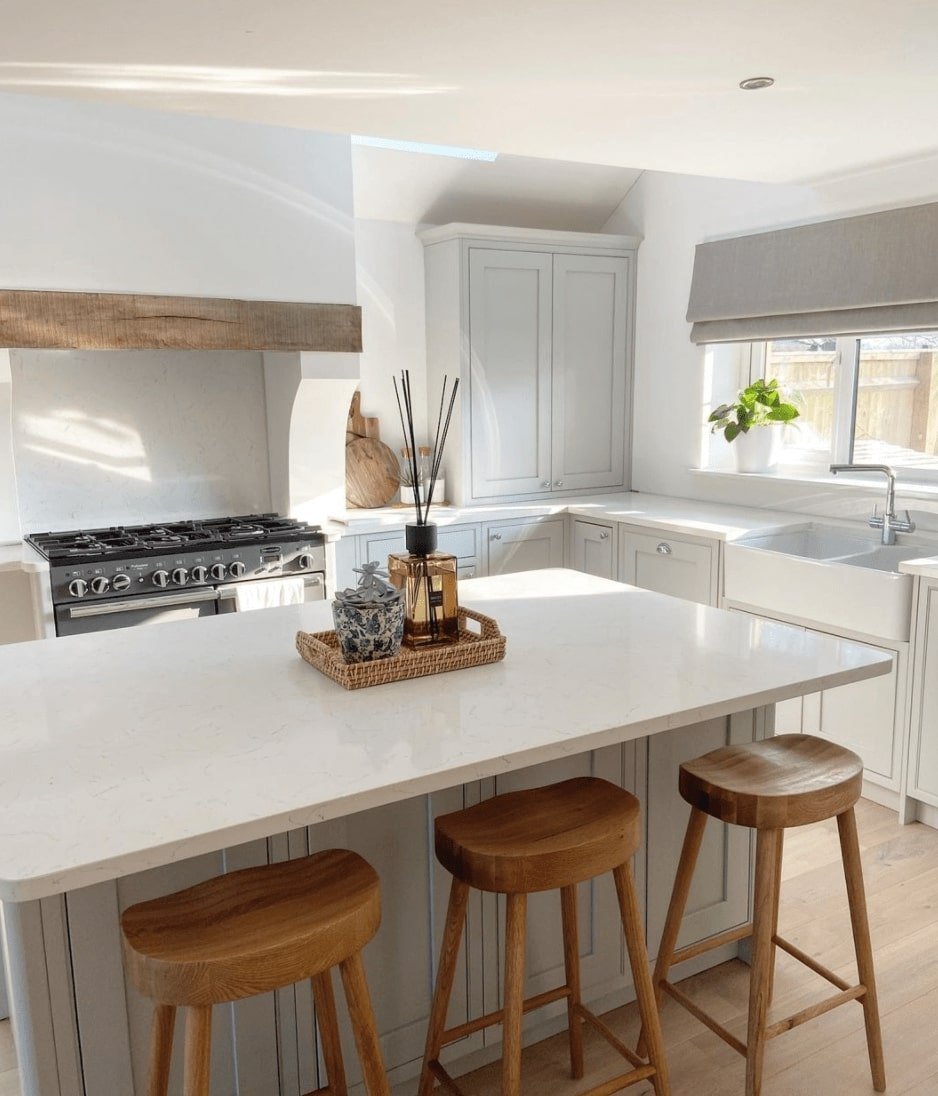How to plan your kitchen – with ZERO regrets
So, you’re planning a kitchen?!
It’s easily one of the most rewarding elements to improving a home. You have the unique ability to create from scratch one of the most important rooms in a property. It’s your chance to have everything you want and everything you need within it. And end up with a kitchen that brings a sense of pride to your home life for a lifetime of happiness cooking meals, baking, entertaining and enjoying all the Christmasses and memories to follow for you and the future owners of the house.
Planning a kitchen is rewarding, but it certainly isn’t easy. So if you’re wondering how to design a kitchen, this guide is going to get you asking all the right questions.
When you’re investing thousands of pounds into a kitchen project, and going through weeks (or even months) of disruption to install it, the last thing you want is to have regrets.
So in this post, I’m sharing the pivotal questions you need to be able to answer – confidently – to ensure you plan your kitchen with zero regrets.
Let’s get started!
By the way, hello if you’re new here! I’m Fi, a renovation addict turned interior designer. I transformed an old, wallpaper + fluffy carpet monstrosity dining room into my dream kitchen, renovated a 1930s house with my partner Neil, then trained as an interior designer to help you, clients and students do the same. My kitchen changed my life more than it changed my home. I want to help you achieve similar results. So keep reading…
As we begin, I’m going to presume you already have an understanding of the shape and layout of the room you’re planning the kitchen for.
You might be doing a kitchen extension, rear extension, or a more modest knock-through or refitting an existing kitchen, wondering how to get the best layout, so let’s start with the one question that might help layout planning all to fall into place…
Planning a kitchen layout – The design questions you need to ask:
A SHAKER KITCHEN - IMAGE @KATYEBH
1. How will I optimise natural light?
With every design project, identify your main sources of natural light first – especially if you’re planning an open-plan kitchen diner like Katy’s. Ask yourself whether the light entering can be optimised in any way. In a kitchen extension or side return, this could be done by adding skylights or glass doors. Otherwise it might be by swapping windows and the back door to thinner frames, or changing window dressing to allow daylight through.
Observe and make notes on how the sunlight would move through the room throughout the day and then look at how you can bring more light into the room via the sides and up above. I’ve got ideas for kitchen lighting in this article if you need to bring light in with ceiling and pendant lights in a stylish way.
IMAGE: Lauren’s open plan kitchen diner @thelittleterracedhouse
2. Where will I spend most of my time?
If your project involves an open-plan or semi-open-plan layout that needs to accommodate a kitchen, dining room and living space all in one, how you answer this question will give you an idea on how to lay out the room.
When architects and designers are planning a kitchen layout they tend to position the most important areas (i.e where you spend the most time as a family) in the areas that attract the best natural light.
Are you the sort of family who loves to spend time relaxing in front of the TV, reading books or playing games during daylight hours on weekends? Then position your living area in the area with the most natural light.
Do you love cooking and entertaining in the kitchen? Do you spend daylight hours/weekends baking and meal prepping? Then position your kitchen where natural light is at it’s best. Try to get into the mindset of how you might use the room in future, maybe you would use the kitchen/diner space more if you ended up creating the ideal space.
3. How will I extract food smells and condensation?
This is very important to determine early on when you’re planning a kitchen simply because extractor hoods and fans inform the design of the kitchen itself. Retrofitting an extractor setup is far harder to do when a kitchen is in situ and will compromise the design if you have to add it in later.
Ideally, your extractor hood should vent to an external wall. Often when there’s little room for ducting, kitchen designers ‘borrow’ space within a kitchen cupboard to disguise the duct within the cupboard. But in my view, that’s a waste of storage space. Research your options heavily. There are now some amazing countertop extraction solutions on the market such as Bora which sit neatly next to a hob, integrated into your worktop. We shared a post about how we extract through the chimney breast in our kitchen because it threw some real challenges during the build – so plan ahead and start conversations with your builder/joiner before your kitchen order is placed.
a HOWDENS KITCHEN
4. What is essential? Start a list
When there are SO many different kitchen solutions on the market, from open shelving, pan drawers, integrated bins and appliances, to glass cabinet doors, spice racks, under sink drawers, you name it – how do you cut through the possibilities and decide on what’s right for the way you live? How do you ensure you’ve remembered everything? (we’ve all seen those houses on Rightmove that have their fridge in a completely weird location because they’ve not thought ahead about the placement!)
The solution is to make a list of everything you (and other primary users) need in the room – from the sink (and the type of sink, if you know what you want already) to the appliances, and lighting. Start with what’s essential in the room and this will ensure you’re putting emphasis on the right solutions for you – not getting led astray by ideas on Pinterest that may or may not be right for your lifestyle which can distract you from what is important to you.
IMAGE: KATARINA’S BEAUTIFUL NEPTUNE KITCHEN (@KIKIANDBOW)
5. What’s on my “nice to have” list?
With your essentials list formed, now write down what your dreams are for the kitchen if money was no object. List everything from Marble worktops to that Belfast sink. This doesn’t just help you to imagine your dream kitchen, it helps you to clearly communicate with yourself, a partner and/or a kitchen designer your thoughts on how the space could look.
There are many cost-saving solutions when designing a kitchen so regardless of your budget, if you have a dream to start you off, you’ll find a way to create the look. Take marble worktops as an example. If you discover Corian, Granite or a Solid surface is out of your budget, explore realistic looking laminate worktops that will still provide you with a great look, but within budget. The key is to build your “nice to have” list to get you exploring what your hopes and dreams are for the room.
Plan your kitchen design with me! Free 3 day design guide
How to avoid common (and expensive!) design mistakes
I’ll show you the easy technique I use to bring cohesion
…and you’ll learn the 3 curveballs to watch out for when you’re designing your room!
6. While planning a kitchen think, “is there anything I can salvage?”
This is something I wish I asked myself more throughout our renovation because with hindsight and now that I’ve worked with people on their kitchen plans, it’s shown me that’s it’s possible to save money by salvaging parts, not to mention it’s better for the planet. This all requires planning.
Are you moving or replacing an existing kitchen that is in OK condition? Inspect the base units (white carcasses) to determine whether these can be used again. Often, a joiner will be able to re-hinge new doors and end panels onto a pre-existing base unit which will save you money.
If you’re doing more extensive work, can windows or doors be used elsewhere in the property? Can anything be sold for parts giving you more budget for the kitchen design? When you’re planning a kitchen try to consider all options for salvaging parts and you could save yourself money and be better to the environment.
We fitted a Howdens kitchen to our home and wrote a full howdens kitchens review in case you’re considering them as a supplier for yours.
IMAGE: @MY_BEst_LAID_PLANS
7. What will every view be like?
When you’ve got the basic outline of possible layouts, standing in the room and pretending it’s all laid out in front of you could reveal more ideas to optimise the space and your views. Pay special attention to your view from your sink, for example. It’s a place you will spend a significant amount of time washing up and gazing into the distance, do you like what you see? How can you make it better?
The same can be said about your view standing at a kitchen island, or seated at a breakfast bar – what will you or guests see? How can you make this better or more sociable? Ideally, you want any bar stools on a kitchen island or breakfast bar facing a view of a focal point in the kitchen such as a cooker or sink rather than a wall of floor to ceiling cupboards which will also make the space more sociable.
8. Is there a clear focal point and balance in the room?
I remember a client sending me a 3D proposal that their kitchen designer produced, sharing how they felt like it was ‘off’ and they couldn’t explain why.
You see, the designer had placed an appliance wall as the focal point of the room. The real focal point was hidden from view. I suggested swapping these around and it made a huge difference to the overall balance of the space.
So my first port of call is to check whether there is balance in the room. For example if there’s a wall of tall cupboards overpowering one side of the room it can throw things ‘off’. Try to tuck tall cupboards around corners so they aren’t the first thing you see when you walk into a kitchen.
When you’re planning a kitchen, ask yourself:
Is there a clear focal point? Such as a cooker with extractor or sink area.
Is that focal point in a location you’ll be able to see as you enter the room? Then look at what’s happening around the focal point – is there an even balance of tall cupboards and wall space?
Is there enough wall space on show (which can make a small room feel bigger)?
Using a kitchen design tool can help you to visualise this a lot better.
KITCHEN ISLAND - IMAGE: @theharehome
9. When guests visit how can I optimise the layout?
This is important to establish as you plan a kitchen and you regularly entertain or host at Christmas. Try to role play the events of multiple people visiting. Where might they linger as they enter? Where will you usher them to sit? Will there be enough seats? Do you want a place to sit for a drink while you finish meal prepping, such as an island with bar stools? Positioning your island is important too; they’re great for socialising but think about crowding when meal prep space is at a premium.
10. When I come home from the food shop, how can I optimise layout?
Role play this. Imagine yourself and the kids/other half coming through your front door with heavy shopping bags, straight into the kitchen. Is there enough space for you to put shopping bags on a worktop? Does the fridge cause an obstruction if it’s left open for a while as you’re unpacking? How can you optimise the layout so there’s enough space for you to perform tasks with minimal stress maximum ease?
11. Is there anything I can add to my kitchen design now that will benefit my life later?
Future-proofing the design is another important factor to consider while you’re planning a kitchen. Consider your lifestyle in 5, 10, 15 years time and how it will change. How can your kitchen design adapt to your requirements? Consider future buyers of your property too. Installing a large fridge and a dishwasher are must-have appliances for anyone starting a family and prospective buyers, and if you’re building a business or planning to work from home like many of us are now, you might wish to install a boiler tap for speedy tea and coffee making, and a water filter system for better drinking water.
A SIDE RETURN KITCHEN - IMAGE: @RAINDROPCOTTAGE
12. Will I still adore this design in 5, 10, 15 years time?
You want a kitchen that is timeless. One that you either don’t have to change at all, or one that will lend itself well to the decoration changes you like to do to your home over the years.
A regret we have was not opting for paintable kitchen cupboards. I shouldn’t call it a ‘regret’ as such, because we did consider it but at the time we couldn’t go with it because paintable kitchen cupboards were more costly – our budget couldn’t stretch. Instead, we chose neutral units with the possibility to suit different wall colours and tiles choices if we want to update the room over the years.
13. Will the materials I am choosing age well?
The biggest tip I can give you during your kitchen planning is to choose worktop materials, tiles and flooring that you’re comfortable maintaining. If you can’t see yourself oiling wood worktops, and don’t trust yourself remembering to put hot pans down on heatproof mats, don’t jeopardise the longevity of your kitchen design for a style that isn’t practical for your lifestyle habits. Choose materials that are comfortable for your lifestyle.
Getting support with your kitchen planning
If you can confidently find the answers to these questions throughout your kitchen planning you’ll have very few regrets. Approach your kitchen design focussing on your practical needs from the space first, that’s how you end up with a kitchen you’re proud of for years to come.
The final thing I want to ask you is… do you find yourself getting sucked into Pinterest with magpie tendencies, unable to define the style of kitchen you want for your home? Then please do consider joining my Home Design Lab program where UK homeowners are learning the ropes to interior design. Lindsey, one of my recent students said “I loved it all. It's just great to know the right step-by-step approach. I feel like I'm on a journey and not just stumbling around on Pinterest!” Take a look at Home Design Lab now. And remember to sign up to our free Design Your Dream Home guide for tips on budgeting and designing your kitchen.
Thanks for reading and I hope this has helped you tackle your kitchen planning with your lifestyle in mind.
Fi xoxo













